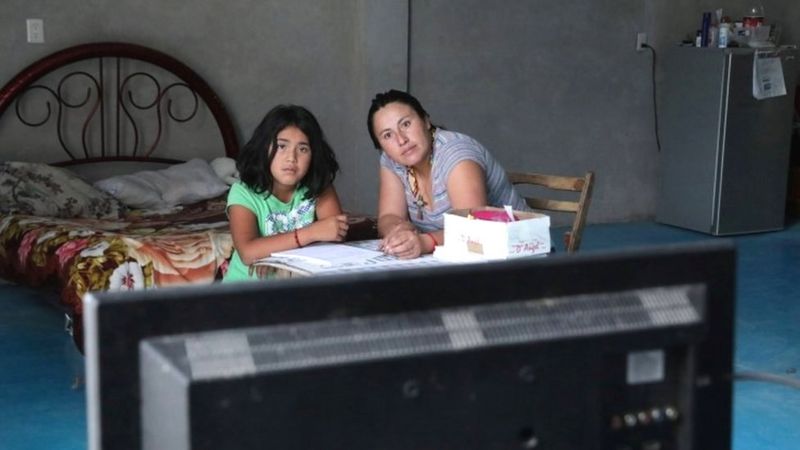
A mother is helping her daughter study – Source: BBC
The educational sector worldwide has recently come under a lot of pressure, having to shift to distance learning. The Mexican government decided to close the schools on March 20th, and classrooms have not reopened since. Private schools are using a combination of Ipad, computer and online classes through Zoom in order to continue their student’s education.
Most students that attend private schools also have parents that can stay at home or have family members or a nanny that can help them with their studies. Students that attend public schools on the other hand, often do not have those luxuries. Late august, at the beginning of the school year, the Mexican government announced that public schools would take on a different approach: they launched the project ‘Aprende en casa II’ (Learn at home II), which will educate students enrolled in public schools through television. It is estimated that 94% of the families have a television at home, broadcasting classes is thus a valid choice in trying to reach as many students as possible. Indigenous communities will be able to follow classes through government radio stations. Besides the screening of classes on television, the government is also providing free textbooks for the students. The recorded classes are also available on the internet website from the government and on the government’s youtube-channel .
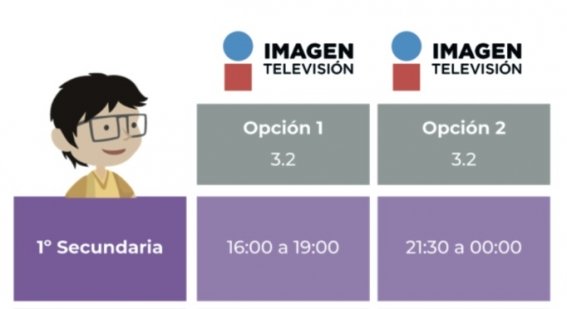
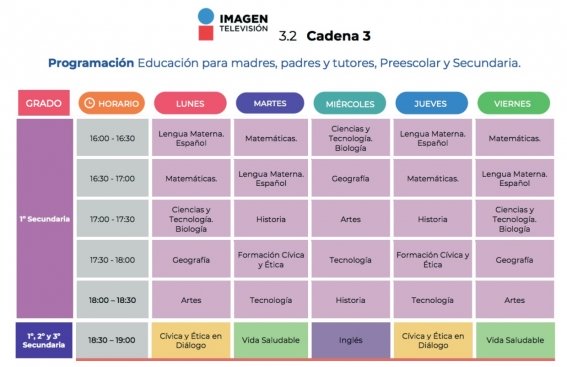
An example of the schedule for the first year of secondary school – Source: SEP
UNICEF is estimating that about 463 million students worldwide have been cut off from education. About 131 million, or 91% of the students in Latin America and the Caribbean are potentially being reached and 9% or 13 million students are not being reached at all. We do need to read these numbers carefully and have to be cautious with the word ‘potentially’. The type of distance learning where students follow classes by television demands a great effort from both students and parents. We need to be aware that many students that have access might not be able to actually follow the classes or apprehend everything. Also, the group of people that are not being reached are exactly the most vulnerable in our society and thus are at greater risk of falling behind.
Low-income countries predominantly implemented radio-based instruction, whereas middle-income countries relied primarily on television and digital media – UNICEF
Different strategies are being used with regards to distance learning with different countries or even regions using diverse approaches. The use of television for education is definitely not new. We can find its origins in the development project ‘Telesecundaria’ that was implemented in the 1960’s. Telesecundarias were established in rural Mexican communities and in poor areas on the outskirts of cities. Children followed classes in a building through television with a coordinator (not teacher) that helped them to work on assignments afterwards. Although the Mexican government almost canceled the project, it did eventually continue and is still a common way how people in rural areas receive education today. During the project in the 1960’s, research showed that students had similar results as those in regular education and this style of teaching and learning was cheaper for both parents and the government due to the low costs of implementation.
This result seemed to argue that when media are used even in an unconventional way to teach the same content as in traditional schools, they can promote greater equality of opportunity for students who have been left out – Mc Anany, 2012, Saving the world: A brief history of communication for development and social change
Although this project has proven to be successful and taught us that television can be used as an effective tool for learning, the context today is different and children lack having assistance with their homework as is the case in the telesecundarias. Now this task is given to the (grand)parents, who are often not qualified as a teacher or instructor or do not have the time. 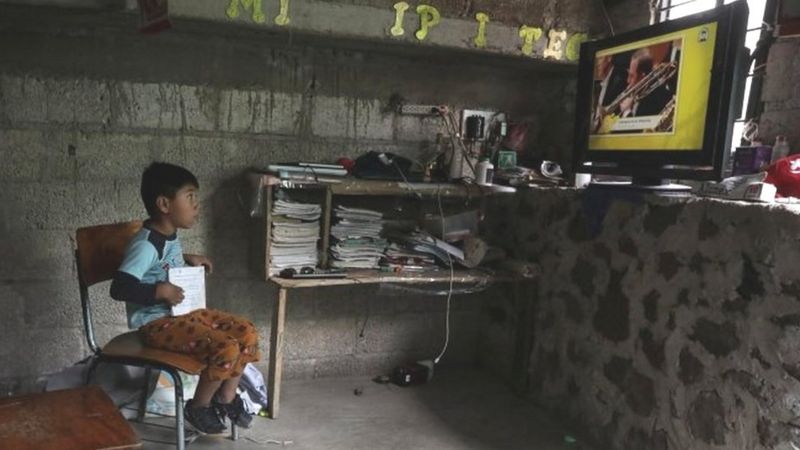
A boy follows music classes through television – Source: BBC
This original communication for development project has turned out to be successful and many students in rural areas in Mexico that would otherwise have been left out were able to receive education. I believe no one however expected the same system to be used on a national level during the COVID-19 pandemic. Although in theory the idea seems great, I believe many people are still left out and struggle with distance learning. It requires great effort from both students and parents and thus can be challenging depending on the social context and living situation. What about single moms? Parents that both work full time? Grandparents that are sick or cannot help? Do people leave their children alone? How are we sure everyone is actually attending the classes without adult supervision? I believe there are still many questions to ask about online learning and its efficiency. The use of ICT’s for development and within education has proven to be successful in the past. However, the way it is being used today does not necessarily mean everyone is being reached or receives the same quality education. This digital divide is becoming more and more prominent and we are clearly seeing a divide in education as well. You will be able to read more about the digital and educational divide in another blogpost!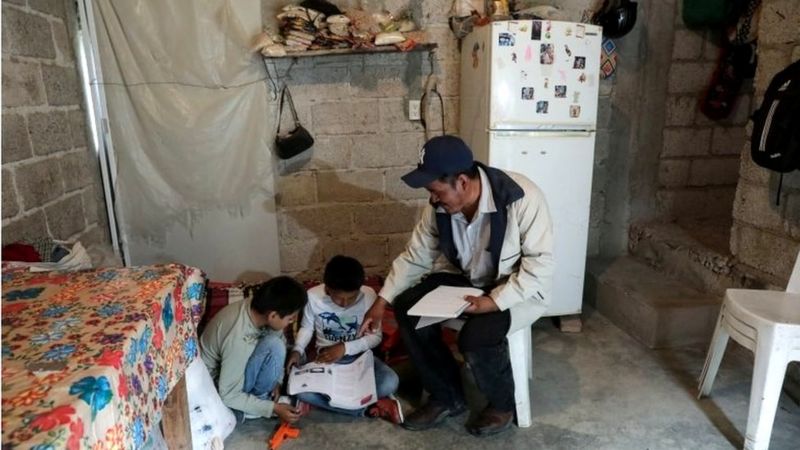
A (grand)parent helps children study – Source: BBC
While European countries are reopening schools, Mexico decided to keep the schools closed. They will only open playgrounds, public parks and schools when the ‘traffic light’ is green. This means when the COVID-19 cases are at an absolute minimum. It seems the children are the ones who are paying the price during this pandemic in order to protect their elders, who they often live together with. The fact that many generations live together and the high numbers of people with obesity and diabetes in the country (two of the most common co-mortalities with COVID-19) might be at the base of the decision to keep children at home.
I am however worried about this generation of children. Are we using them to experiment on the efficiency of distance learning? How far will they be behind? These children have been going on for months without being in an actual classroom, without being able to go to the park or practice hobbies. So far there is no near end in sight, with all Mexican states except for one being in the orange and red zones. Many believe the distance learning will at least continue until next year, if not until the end of the school year. At this stage, we can only wonder what will be the consequences for these children in the long term. I do feel the Mexican government is doing its best and is also succeeding to reach as many children as possible by offering a fully embedded online approach through different media channels. By using television, YouTube, radio and an online website, they are using a fully integrated approach in ICT for development, which can serve as an example for other countries that are in need of reaching more students. The issue with this type of learning is that it relies purely on the students and parents their willingness and effort to attend classes, make homework and keep studying. Although usefull and necesarry now, we can only guess about the long-term effects of this type of education.
Sources:
McAnany, Emile G. (2012) Saving the World: A Brief History of Communication for Development and Social Change. Champaign, IL: University of Illinois Press.
BBC – In pictures: Mexico school classes resume on tv
https://www.bbc.com/news/world-latin-america-53917882
UNICEF Report, 2020, COVID-19: Are children able to continue learning during school closures? A global analysis of the potential reach of remote learning policies using data from 100 countries.
Roberts, T. 2019: Digital Development: what’s in a name? (Links to an external site.) Appropriating Technology, 9 August.





